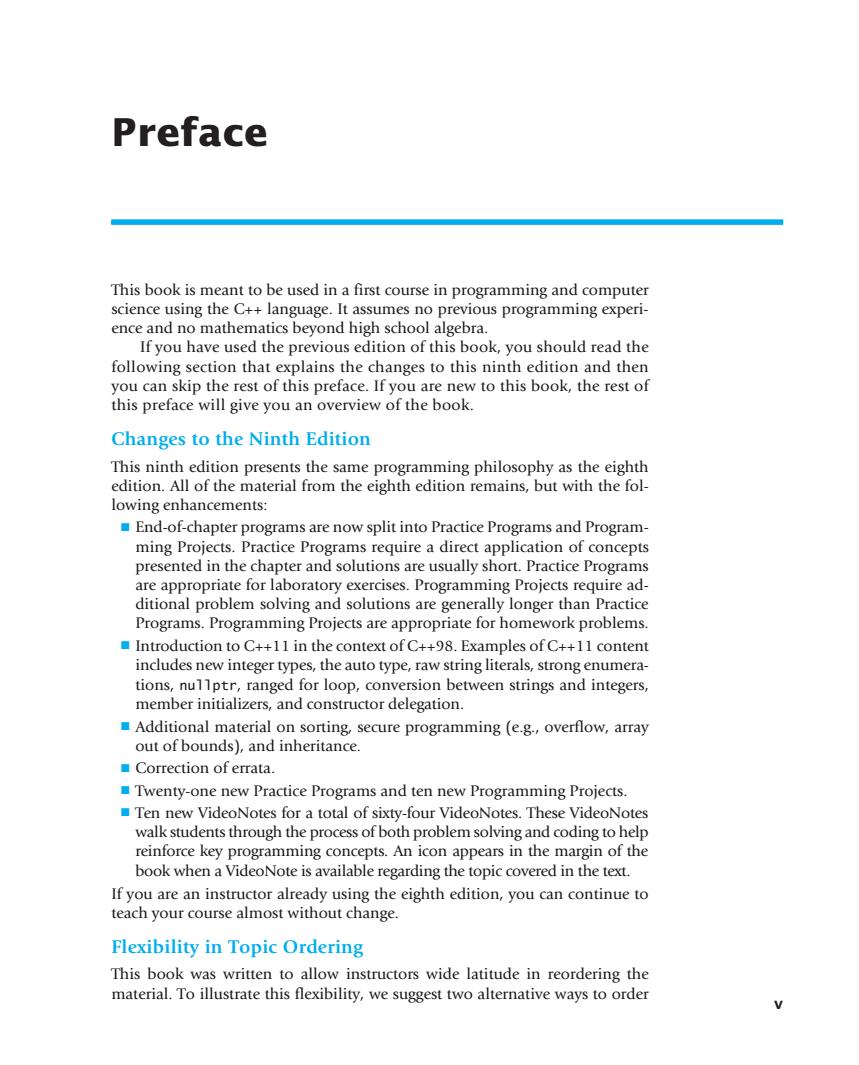正在加载图片...

Preface This book is meant to be used in a first course in programming and computer science using the C++language.It assumes no previous programming experi- ence and no mathematics beyond high school algebra. If you have used the previous edition of this book,you should read the following section that explains the changes to this ninth edition and then you can skip the rest of this preface.If you are new to this book,the rest of this preface will give you an overview of the book. Changes to the Ninth Edition This ninth edition presents the same programming philosophy as the eighth edition.All of the material from the eighth edition remains,but with the fol- lowing enhancements: End-of-chapter programs are now split into Practice Programs and Program- ming Projects.Practice Programs require a direct application of concepts presented in the chapter and solutions are usually short.Practice Programs are appropriate for laboratory exercises.Programming Projects require ad- ditional problem solving and solutions are generally longer than Practice Programs.Programming Projects are appropriate for homework problems. Introduction to C++11 in the context of C++98.Examples of C++11 content includes new integer types,the auto type,raw string literals,strong enumera- tions,nullptr,ranged for loop,conversion between strings and integers, member initializers,and constructor delegation. Additional material on sorting,secure programming (e.g.,overflow,array out of bounds),and inheritance. Correction of errata. Twenty-one new Practice Programs and ten new Programming Projects. Ten new VideoNotes for a total of sixty-four VideoNotes.These VideoNotes walk students through the process of both problem solving and coding to help reinforce key programming concepts.An icon appears in the margin of the book when a VideoNote is available regarding the topic covered in the text. If you are an instructor already using the eighth edition,you can continue to teach your course almost without change. Flexibility in Topic Ordering This book was written to allow instructors wide latitude in reordering the material.To illustrate this flexibility,we suggest two alternative ways to orderv Preface This book is meant to be used in a first course in programming and computer science using the C++ language. It assumes no previous programming experience and no mathematics beyond high school algebra. If you have used the previous edition of this book, you should read the following section that explains the changes to this ninth edition and then you can skip the rest of this preface. If you are new to this book, the rest of this preface will give you an overview of the book. Changes to the Ninth Edition This ninth edition presents the same programming philosophy as the eighth edition. All of the material from the eighth edition remains, but with the following enhancements: ■ End-of-chapter programs are now split into Practice Programs and Programming Projects. Practice Programs require a direct application of concepts presented in the chapter and solutions are usually short. Practice Programs are appropriate for laboratory exercises. Programming Projects require additional problem solving and solutions are generally longer than Practice Programs. Programming Projects are appropriate for homework problems. ■ Introduction to C++11 in the context of C++98. Examples of C++11 content includes new integer types, the auto type, raw string literals, strong enumerations, nullptr, ranged for loop, conversion between strings and integers, member initializers, and constructor delegation. ■ Additional material on sorting, secure programming (e.g., overflow, array out of bounds), and inheritance. ■ Correction of errata. ■ Twenty-one new Practice Programs and ten new Programming Projects. ■ Ten new VideoNotes for a total of sixty-four VideoNotes. These VideoNotes walk students through the process of both problem solving and coding to help reinforce key programming concepts. An icon appears in the margin of the book when a VideoNote is available regarding the topic covered in the text. If you are an instructor already using the eighth edition, you can continue to teach your course almost without change. Flexibility in Topic Ordering This book was written to allow instructors wide latitude in reordering the material. To illustrate this flexibility, we suggest two alternative ways to order